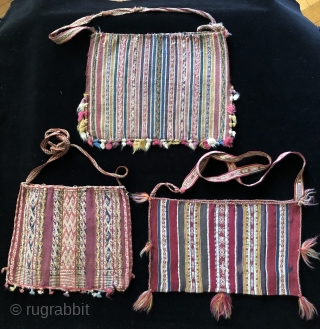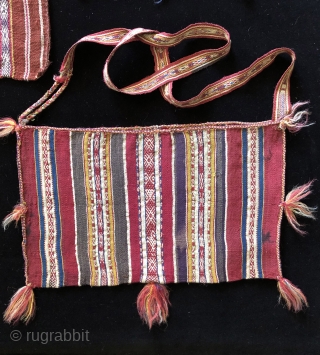Back
Tutorial Part 7 – Shapes, Sizes and Design Range in Aymara Coca Bags
Featured here is a cluster of 19th century Aymara coca bags. i plan to use images of these bags and others to demonstrate the range of size, shape and design variations found in Aymara coca bags. In this and following posts i hope to paint a good picture of the range and remarkable quality of these rare and beautiful weavings.
When i first started collecting Aymara textiles in 1979 i began with Coca bags. i had been buying 19th century tribal bags and rugs woven by various Near Eastern and Central Asian peoples. When i first discovered Aymara material, i immediately recognized the value in them. Here were beautifully woven, naturally dyed 19th century bags that were a fraction of the cost of the equivalent 19th century Turkmen or Shah Sevan sumac bags. And, as i soon found, - even considering the rarity of such things - Aymara weavings were then and have remained little understood, virtually undiscovered. Today they continue to represent great value in the antique textile marketplace, but are increasingly hard to come by. Little did i know back in 1979 that my detour into Andean textiles, this infatuation these pieces would be the start of a journey of discovery that would eventually turn me into one of the world’s experts on Andean textiles – from both the pre and post conquest periods.
Bag sizes. Aymara Coca bags range in size from approximately 5 x 6 inches to 14 x 11 inches. The most common size range is somewhere in between these two dimensions. Basically, very small bags and very large bags are seen less frequently than other mid-sized bags. The largest bags tend to be earlier, but this is not set in stone. Large bags tend to denote prestige and importance – they hold more coca leaves - but small, fine little bags were clearly a source of pride as well. It is thought that smaller bags are more often used by women, but this again is not a hard and fast rule.
The shapes of coca bags are quite varied, but are often determined by the region where they were made among other factors. Lake Titicaca area bags for example tend to be more finely woven than in other areas and are substantially wider than they are deep. This very wide shape is diagnostic of Lake area coca bags. The region around the Lake Titicaca was historically more settled than other areas of the Altiplano because the lake is such an enormous and deep body of water that its volume moderates the temperature near the lake making it more habitable. Because of this, farming was more productive and reliable and this warmer climate combined with plentiful aquatic life of fish and waterfowl made it a place where the most influential and important Pre-Columbian cultures like Tiwanaku flourished. The more urban and cosmopolitan culture that developed in the Lake region fostered a more refined weaving culture. Lake area coca bags are almost always quite finely woven and much wider than they are tall. This is not seen in the bags of other Aymara regions. They can also have dyed red wefts rather than the typical natural brown wefts of most other bags. They have a fine weave and delicate small-scale designs consisting of geometric and animal and plant forms. In general, most coca bags from other areas are a bit wider than tall, but they can be taller than they are wide as well. Sometimes they are nearly square.
Coca bags can have a myriad of design layouts. Perhaps the most archaic is the layout of three pattern bands on a single colored or multi colored ground. Another layout is one where multicolored bands of design run across the entire width of the bag. Some bags have what is referred to as a vacant center where there is no central patterned band, but a plain field or one made up of bi-chrome yarns. Other bags can have a combination of prominent pattern bands with secondary pattern bands on a varicolored ground. Some bags have no pattern bands only colored stripes.
Few Aymara bags have survived with their original straps and edge finishes. Often straps and edges are badly damaged or replaced with something else. Some bags appear to have been made without straps. It is unusual when a bag manages to survive with an original strap like the wider than deep Lake area bag pictured here. More to follow in another post. Also see parts 1 - 6 on my pages. Stay tuned.
price:
ALL SOLD
- Home
- Antique Rugs by Region
- Category
- Profiles
- Post Items Free
- Albums
- Benaki Museum of Islamic Art
- Budapest: Ottoman Carpets
- Gulbenkian Museum
- Islamic Carpets. Brooklyn
- Islamic Textiles. Brooklyn
- Konya Museum: Rugs
- MKG, Hamburg
- MMA: Caucasian Carpets
- MMA: Mamluk Carpets
- MMA: Mughal Indian Carpets
- MMA: Ottoman Carpets
- MMA: Safavid Persian Carpets
- MMA: Turkmen Rugs
- McCoy Jones Kilims
- Ottoman textiles. Met
- Philadelphia Museum
- Rugs and Carpets: Berlin
- Seljuqs at the Met
- TIEM, Istanbul: Carpets
- V&A: Classical Carpets
- Vakiflar Carpets: Istanbul
- Baluch Rugs: Indianapolis
- Gallery Exhibitions
- Jaf an Exhibition
- Alberto Levi Gallery
- Andean Textile
- Christie's London: 2016
- Francesca Galloway
- HALI at 40
- ICOC Washington, DC 2018
- Jajims of the Shahsavan
- London Islamic Week April, 2018
- Mongolian Felts
- Navajo Rugs: JB Moore
- Persian Piled Weavings
- SF Tribal & Textile Art Show 2020
- SF Tribal 2019
- Sotheby's: C. Alexander
- Turkish Prayer Rugs
- Turkmen Main Carpets ICOC 2007
















